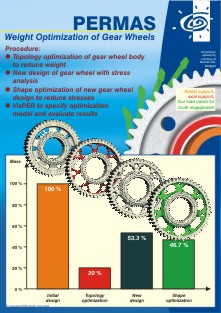PERMAS-TOPO Topology Optimization
Topology optimization is a method to find in a given limited part of space a finite element structure being optimal
relative to a user defined criterion and fulfilling a set of given conditions. For this task a part of the model, the design
space, has to be filled with finite elements. Each finite element gets its own design variable, the filling ratio (with
values between 0 and 1; SIMP-approach). It is used for the calculation of a scale factor for the elemental stiffness. If the filling ratio is near
zero, so is the stiffness. The the respective finite element does not contribute to the mechanical behavoir of the structure
and can be neglegted. The elements with high filling ratios are the necessary ones to fulfil the given criteria.
It is clear that the layout found by this process consists of a subset of the elements of the design space. The finer you
discretize the design space the more detailed the layout result can be, but the higher is the computation effort.
A general objective function facility can be used to set up an objective function dependent on multiple constraint values (like max/min, absmax/absmin, RMS).

Multi-Modal Optimization of a cylindrical shell.

Topology optimization of an aircraft front fuselage.

Topology optimization of a control arm.
A subsequent shape optimization is a step to realize a simulation driven design (OPT). The remaining structure can be further processed by one of the following means:
For the modeling continua elements like membranes, shells, and solids are used and sub-structuring is supported.
Supports the concept development stage by providing fully integrated topology optimization strategies:
- Design space specification with variable/fixed parts,
- Provide boundary conditions,
- Provide loads,
- Target definition with remaining volume,
- Additional constraints for the optimization, if any.
Additional modeling parameters are:
- Fixed/free Design elements:
- filling ratio per design element,
- design variable limits,
- design variable modification limits.
- Release Directions: For casting special constraints have to be applied in order to get producible parts out of a topology optimization. So, release directions can be specified to control this kind of manufacturing constraint. In addition, a minimum resudial wall thickness can be specified to obtain a closed structure (like housings). A fixed mold parting line can be specified in case of opposing release directions.
- Symmetry conditions: Planar, axial, and cyclic symmetry conditions can be specified to determine the final properties of the layout result.
- Repetitive structures: Design element linking is provided to get the same layout for different parts of the structure.
- Maximum member size: In combination with release directions a maximum member size option is available to restrict the thickness of remaining structures.
- Minimum member size: Minimum member sizes in the remaining structure (i.e. widths and thicknesses) can be controlled by corresponding parameters (so-called checkerboard filter).
Design constraints and design objective
In each optimization constraints shall limit the value range for design variables as well as for the response quantities like:- Displacements, velocities, accelerations,
- Element forces,
- Reaction forces,
- Stresses,
- Compliance,
- Weight,
- Contact gap widths,
- Contact pressure,
- Contact forces,
- Eigenfrequencies,
- Buckling load scale factors,
- Sound radiation power density,
- Temperatures,
- Heat fluxes,
- General constraints as combination or arbitrary function of the above mentioned quantities. Such functions include global criteria like max/min, absmax/absmin, or RMS.
- Element quality, where the PERMAS element test is mapped to a continuous variable with values between 0. (i.e. perfect element) and 1. (i.e. erroneous element).
This design contraint will help to avoid the failure during optimization due to collapsing elements
Each design constraint can also be used as objective function.
Design constraint functions can be used to build more complex
constraints out of the above listed basic constraints.
A general objective function facility can be used to set up an objective function dependent on multiple constraint values (like max/min, absmax/absmin, RMS).
A general objective function facility can be used to set up an objective function dependent on multiple constraint values (like max/min, absmax/absmin, RMS).
Multi-Modeling
- several load cases simultaneously with different superposition options,
- different design variants.
- different design variable types.

Multi-Modal Optimization of a cylindrical shell.
Analysis options:
- Linear statics (and inertia relief),
- Contact analysis,
- Linear buckling,
- Dynamic eigenvalue analysis,
- Modal frequency response analysis.

Topology optimization of an aircraft front fuselage.
Optimization algorithms:
In contrast to bionic algorithms, based on stress reduction and growth rules, PERMAS uses mathematical optimization algorithms.- GCA Global Convex Approximation
for eigenfrequencies and a combination of static and dynamic constraints. - ACP Adapted Convex Programming
- and further methods like, SLP,SQP,...
The iterations of an optimization can be controlled either by the convergence of the objective function or by a maximum number of iterations.
Beside the history of the objective function, the result of a layout optimization is the element filling ratio. On the basis of the filling ratio, the remaining structure can be visualized in the post-processor easily.

Topology optimization of a control arm.
A subsequent shape optimization is a step to realize a simulation driven design (OPT). The remaining structure can be further processed by one of the following means:
- Hull generation :
For an automatically determined or prescribed value of the filling ratio the corresponding surface in space is extracted as mesh out of quadrangles and triangles. - Smoothing:
The hull is smoothed taking into consideration the boundary of parts, loads, and kinematic constraints. - Polygon Reduction:
The mesh is purged of too small triangles and quadrangles in order to achieve a surface description as compact as possible. - Export:
The remaining triangle mesh can be exported as FE mesh for post-processing or as a geometry using STL format. generation. - Simulation driven design:
Design of a chassis comonent.


Comparison of a topology optimization of en engine bracket under static loading with the same under static and dynamic loading.
